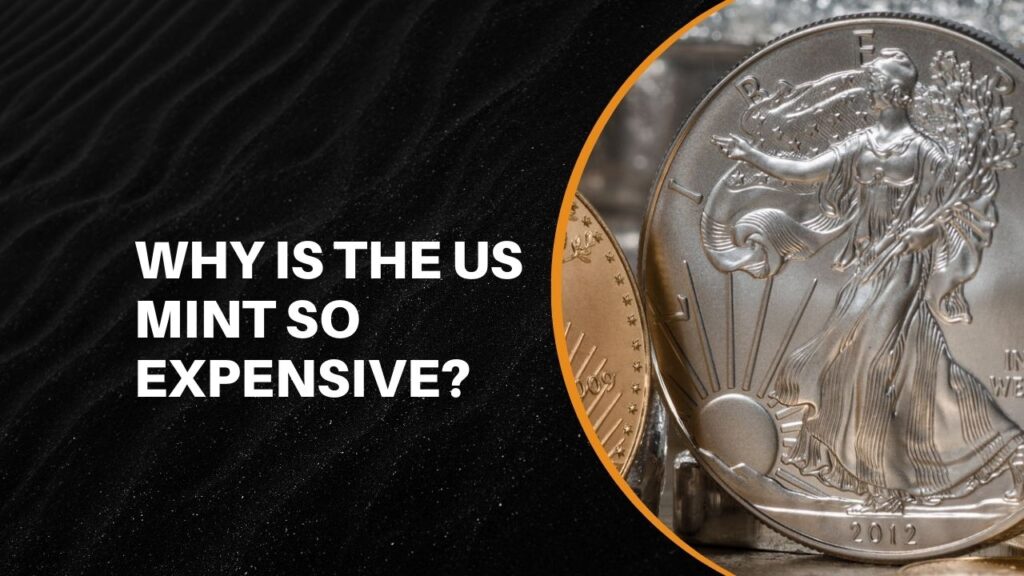Why Is The US Mint So Expensive? The U.S. Mint’s prices are high due to rising metal and production costs, along with the need to cover operational expenses.
The U.S. Mint has played a significant role in American history, producing coins for everyday transactions, as well as special collectibles that capture the nation’s most cherished symbols and figures.
Recently, however, many collectors and numismatists have noticed a steep increase in the prices of U.S. Mint products, particularly limited-edition and precious metal coins.
But why has the cost of these items gone up so much, and what factors contribute to these higher prices? [Why Is The US Mint So Expensive?]
From fluctuations in global metal markets to intricate designs and operational requirements, various elements drive the expense of U.S. Mint products.
In this article, we will explore these contributing factors and discuss whether the investment is worth it for collectors.
What Is the U.S. Mint?
Historical Background
Established by the Coinage Act of 1792, the U.S. Mint was one of the first institutions created by the fledgling American government.
Its initial purpose was to produce a stable and consistent currency for the new nation, eliminating reliance on foreign currency. [Why Is The US Mint So Expensive?]
Since then, the Mint has expanded its duties and facilities, now operating multiple locations across the U.S. with facilities in Philadelphia, Denver, San Francisco, and West Point, each with its unique contributions to the Mint’s operations. Over time, the U.S.
Mint has also become known for its commemorative coins, medals, and collectible items, producing coins that celebrate everything from national parks to prominent American figures.
Main Functions of the U.S. Mint
The U.S. Mint serves two primary functions today. First, it produces the coins that circulate throughout the United States, a task crucial to the country’s economy.
These include pennies, nickels, dimes, quarters, and other denominations commonly used in daily transactions. Second, the U.S. [Why Is The US Mint So Expensive?]
Mint creates collectible items, including gold, silver, and platinum coins, which appeal to both numismatists and investors.
These collectibles are distinct from circulating currency as they often feature special designs, limited runs, and high-quality materials.
Collectors view these items as investments and as part of their collections, making U.S. Mint products some of the most sought-after in the world.
Factors Contributing to Higher U.S. Mint Prices
Rising Metal Prices
The cost of metals is one of the most significant contributors to U.S. Mint product prices. The Mint produces collectible coins using precious metals like silver, gold, and platinum, which can experience dramatic price swings due to global market conditions.
In recent years, the price of these metals has risen, driven by factors like economic uncertainty, supply chain disruptions, and inflation.
Precious metal prices can fluctuate widely based on demand, mining production, and other economic forces. [Why Is The US Mint So Expensive?]
This volatility directly impacts the Mint’s production costs, and when metal prices increase, the Mint must adjust its prices accordingly to cover expenses.
For example, the American Silver Eagle coin’s price has increased alongside the price of silver, reflecting not only the raw material cost but also the demand for a high-quality, government-backed silver coin.
Gold products, like the American Gold Eagle series, experience similar price adjustments, which can be dramatic depending on market conditions.
Thus, for collectors or investors who purchase these coins, the Mint’s prices directly reflect the cost of the precious metals used. [Why Is The US Mint So Expensive?]
Increased Production Expenses
In addition to metal costs, general production expenses have also seen an upward trend. The U.S. Mint operates as a self-sustaining entity, meaning it does not receive funding from the federal budget.
Instead, it covers all costs through its revenue from sales. Beyond metals, production costs include labor, energy, and transportation expenses. The cost of energy has risen worldwide, impacting everything from mining to manufacturing.
Transportation and shipping costs, which surged due to global supply chain disruptions in recent years, have added further pressure.
The Mint also employs skilled labor for coin production, design, and quality control, with these operational expenses covered by product prices.
Furthermore, technological advancements in minting also contribute to the expense. [Why Is The US Mint So Expensive?]
The U.S. Mint consistently invests in new technology to enhance the quality and security of its coins, which can be a costly endeavor.
Implementing anti-counterfeiting features, for instance, requires specialized equipment and labor, which, while essential, adds to the Mint’s overall expenditure.
Quality and Design
The U.S. Mint is known for producing some of the highest-quality coins in the world, thanks to its commitment to exceptional design and craftsmanship.
These coins are not simply mass-produced items; they are carefully crafted works of art, which often feature intricate details, polished finishes, and multi-step production processes.
The American Eagle coins, for example, are among the most iconic designs, depicting highly detailed images of Lady Liberty and the American bald eagle.
Producing coins with this level of detail requires time, expertise, and specialized machinery, all of which come at a premium.
Limited-edition products often feature unique designs or finishes, like proof or uncirculated versions, which add to their appeal.
Additionally, commemorative coins that celebrate significant events, like the U.S. Mint’s series honoring national parks or presidents, come with premium prices due to their limited availability and the historical significance they carry.
These details require additional resources and precision, pushing production costs higher and ultimately affecting the final sale price. [Why Is The US Mint So Expensive?]
Profit Requirements and Operational Costs
Because the U.S. Mint operates as a self-sustaining institution, it must cover all of its operational expenses through the revenue it generates from coin sales.
This means that prices must account for not only material and production costs but also employee salaries, facility maintenance, research and development, and marketing.
The Mint must stay profitable to fund ongoing production and new projects, including the creation of fresh designs, security features, and commemorative items.
Unlike other government entities, the Mint functions much like a business, where revenue must cover costs while supporting its growth and development.
Why Are Collectible Coins Particularly Expensive?
Limited Editions and Rarity
Limited-edition products from the U.S. Mint are especially popular among collectors. [Why Is The US Mint So Expensive?]
These coins are often minted in small quantities, sometimes just a few thousand pieces, and once they sell out, they become highly sought-after in the secondary market.
This rarity can drive up the value of these coins, making them attractive investments for those looking for long-term value or a unique addition to their collection.
The Mint’s use of precious metals in limited quantities, combined with unique designs, adds to the coin’s appeal, allowing the Mint to price them at a premium.
For example, the Morgan and Peace Silver Dollar coins released in recent years had very limited production numbers, leading to high demand and fast sellouts.
The Mint’s strategy to produce only a select number of each design enhances exclusivity, further justifying higher prices and adding appeal to serious collectors.
Demand Among Collectors
Demand for U.S. Mint products remains high, particularly for precious metal coins like the American Silver Eagle, which are highly regarded for both their aesthetic and investment value.
Collectors view these coins as tangible assets that can appreciate over time, especially given the high quality and backing by the U.S. government.
With a loyal base of collectors, the Mint is able to set higher prices that reflect not only the intrinsic value of the coin but also its perceived collectible value.
In addition to traditional coin collectors, the U.S. Mint’s products attract investors looking to add tangible assets to their portfolios. [Why Is The US Mint So Expensive?]
Precious metal coins, especially those made of silver or gold, are seen as safer investments during economic uncertainty, adding another layer of demand.
This broad appeal helps the Mint maintain premium prices.
Comparing U.S. Mint Prices with Other Mints Globally
A brief comparison with other national mints reveals differences in pricing and production methods.
While mints like the Royal Canadian Mint or Britain’s Royal Mint also produce collectible coins, they sometimes have varying prices due to differences in materials, designs, and quantities.
For instance, some mints might produce higher quantities of a particular coin, which can reduce the per-unit price. [Why Is The US Mint So Expensive?]
However, the U.S. Mint’s emphasis on quality, purity, and limited-edition designs has made its coins some of the most respected and sought-after globally, justifying their premium pricing for many collectors.
Is the Cost Justified?
For collectors, the cost of U.S. Mint products is often justified as an investment in both history and tangible assets. [Why Is The US Mint So Expensive?]
The Mint’s coins are not only pieces of American history but also come with the backing of the U.S. government, which adds a layer of security and authenticity that’s appealing to buyers.
Collectors believe that the high-quality design, limited availability, and potential for appreciation make these products worth the investment.
While some might argue that the prices are excessive, the quality, craftsmanship, and historical significance attached to these coins often outweigh the cost.
Investing in U.S. Mint products can also have a financial appeal, especially for those looking to diversify their assets with precious metals.
While no investment is guaranteed, collectible coins with historical and material value tend to retain or increase their worth over time, adding another layer of value for buyers.
See Also: Why Is The Dior X Air Jordan So Expensive?
FAQs
Why are U.S. Mint collectible coins more expensive than regular coins?
Collectible coins often use high-grade metals like silver or gold, require intricate designs, and are produced in limited quantities, making them more valuable and costly to produce.
Do U.S. Mint coin prices go down when metal prices decrease?
While metal price fluctuations impact coin prices, other production costs (like labor and design) may prevent significant price reductions, even if metal prices drop.
Are U.S. Mint products a good investment?
Many collectors see U.S. Mint products as worthwhile investments, given their material value and historical significance, though values can vary based on demand and rarity.
How does the U.S. Mint determine the price of collectible coins?
Prices reflect current metal market rates, production costs, design intricacy, and demand for specific coin series, with additional margin to cover operational costs.
Can anyone buy from the U.S. Mint?
Yes, the U.S. Mint sells directly to the public through its website, making coins and other collectibles accessible to collectors and investors alike. [Why Is The US Mint So Expensive?]
Conclusion: Why Is The US Mint So Expensive?
The U.S. Mint’s higher prices are influenced by several factors, including rising metal costs, increased production expenses, and the demand for limited-edition, high-quality coins.
For collectors and enthusiasts, these products offer a piece of American heritage and serve as potential investments, justifying the cost for many. [Why Is The US Mint So Expensive?]
While U.S. Mint products may come at a premium, they continue to attract buyers who value the craftsmanship, historical significance, and investment potential that each coin represents.

Hello, I’m Ashlyn Fleming from Sedona, Arizona. After finishing my Master’s, I noticed rising prices on everything I buy for my family. Curious about why, I started a blog to share my findings with friends and family.
